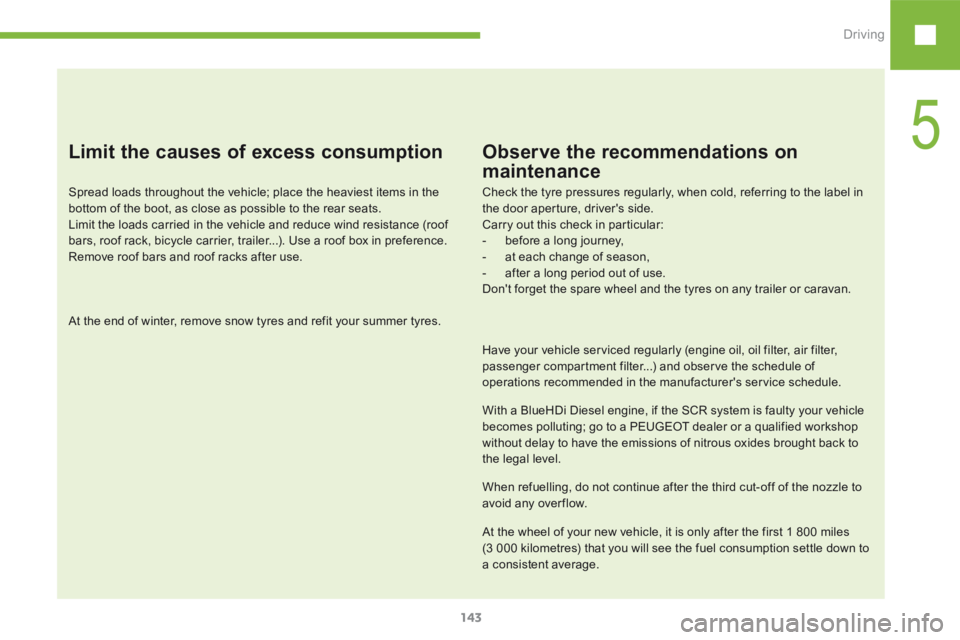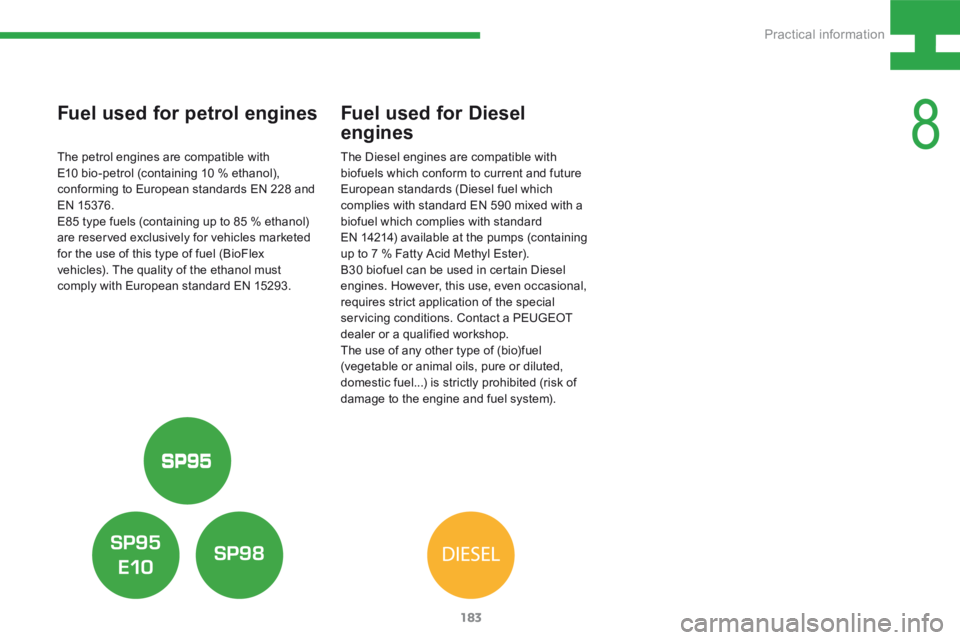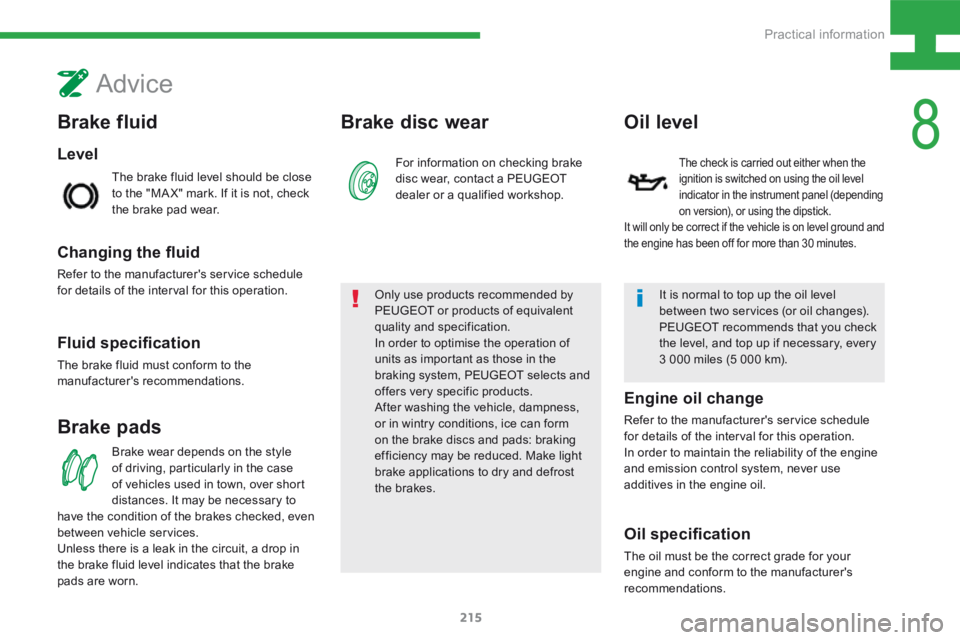Page 60 of 341
58
208_en_Chap03_Indicateurs_ed01-2015
Level incorrect
This is indicated by the flashing of "OIL" or
by the display of a dedicated message in the
instrument panel.
If the low oil level is confirmed by a check using
the dipstick, the level must be topped up to
avoid damage to the engine.
Fault
This is indicated by the flashing of " OIL_ _" or
by the display of a dedicated message in the
instrument panel. Contact a PEUGEOT dealer
or a qualified workshop.
Level correct
It is normal to top-up the engine oil
level between services (or oil changes).
PEUGEOT recommends that you check
the oil level and top-up if necessary,
every 3 000 miles (5 000 km).
Electronic oil level indicator
The check is done for a few seconds on
switching on the ignition with a message in the
display or screen (depending on version).
It is only valid if the vehicle is on level ground
and the engine has been off for at least
30 minutes.
Indicators
Page 145 of 341

143
208_en_Chap05_conduite_ed01-2015
Limit the causes of excess consumption
Spread loads throughout the vehicle; place the heaviest items in the
bottom of the boot, as close as possible to the rear seats.
Limit the loads carried in the vehicle and reduce wind resistance (roof
bars, roof rack, bicycle carrier, trailer...). Use a roof box in preference.
Remove roof bars and roof racks after use.
At the end of winter, remove snow tyres and refit your summer tyres.
Observe the recommendations on
maintenance
Check the tyre pressures regularly, when cold, referring to the label in
the door aperture, driver's side.
Carry out this check in particular:
- before a long journey,
- at each change of season,
- after a long period out of use.
Don't forget the spare wheel and the tyres on any trailer or caravan.
Have your vehicle serviced regularly (engine oil, oil filter, air filter,
passenger compartment filter...) and observe the schedule of
operations recommended in the manufacturer's service schedule.
With a BlueHDi Diesel engine, if the SCR system is faulty your vehicle
becomes polluting; go to a PEUGEOT dealer or a qualified workshop
without delay to have the emissions of nitrous oxides brought back to
the legal level.
When refuelling, do not continue after the third cut-off of the nozzle to
avoid any over flow.
At the wheel of your new vehicle, it is only after the first 1 800 miles
(3 000 kilometres) that you will see the fuel consumption settle down to
a consistent average.
5
Driving
Page 178 of 341
176
208_en_Chap08_Informations-pratiques_ed01-2015
The various caps and covers allow access for
checking the levels of the various fluids and for
replacing certain components.
Petrol
1. Screenwash reservoir.
2. Coolant header tank.
3. Brake fluid reservoir.
4. Battery / Fuses.
5. Fusebox.
6. A i r f i l t e r.
7. Engine oil dipstick.
8. Engine oil filler cap.
Take care when working under the
bonnet, as certain areas of the engine
may be extremely hot (risk of burns) and
the cooling fan could start at any time
(even with the ignition off).
Checking levels
Check the levels regularly, in line with the
manufacturer's service schedule. Top them up
if necessary, unless otherwise indicated.
If a level drops significantly, have the
corresponding system checked by a PEUGEOT
dealer or a qualified workshop.
Practical information
Page 179 of 341
177
208_en_Chap08_Informations-pratiques_ed01-2015
The various caps and covers allow access for
checking the levels of the various fluids, for
replacing certain components and for priming
the fuel system.
Diesel
1. Screenwash reservoir.
2. Coolant header tank.
3. Brake fluid reservoir.
4. Battery / Fuses.
5. Fusebox.
6. A i r f i l t e r.
7. Engine oil dipstick.
8. Engine oil filler cap.
9. Priming pump (depending on engine).
The AdBlue
® additive tank filler is located in the
boot below the spare wheel.
Take care when working under the
bonnet, as certain areas of the engine
may be extremely hot (risk of burns) and
the cooling fan could start at any time
(even with the ignition off).
Checking levels
Check the levels regularly, in line with the
manufacturer's service schedule. Top them up
if necessary, unless otherwise indicated.
If a level drops significantly, have the
corresponding system checked by a PEUGEOT
dealer or a qualified workshop.
8
Practical information
Page 180 of 341
178
208_en_Chap08_Informations-pratiques_ed01-2015
EngineGearbox SpeedsEngine oil capacity*
(litres) Unbraked trailer (kg) Recommended nose
weight (kg)
1.0 PureTech 68 Manual53 .13450 / 600** 30
1.2 PureTech 82 Manual
53 .13 520 46
Electronic 53 .13 520 46
1.2 PureTech 82 S&S Electronic53 .13 500 46
1.4 VTi 95 LPG Manual54.25 570 46
1.2 PureTech 110 S&S Manual5---
1.6 VTi 120 Manual
54.25 580 46
Automatic 44.25 580 46
1.6 THP 155 Manual 64.25 580 46
1.6 THP 200 hp Manual64.25 580 46
1.6 THP 208 S&S Manual64.25 580 46
* Capacity with oil filter replacement.
** Affaire version.
Petrol engines
Practical information
Page 181 of 341
179
208_en_Chap08_Informations-pratiques_ed01-2015
* Capacity with oil filter replacement.
** Affaire version.
Diesel engines
EngineGearbox SpeedsEngine oil capacity*
(litres) Unbraked trailer (kg) Recommended nose
weight (kg)
1.4 HDi 68 Manual 53.75400 / 600** 29
1.4 e- HDi 68 Electronic 53.75500 / 600** 29
1.6 HDi 75 Manual 53.75 --
1.6 HDi 92 Manual 53.75 --
1.6 e- HDi 92 Manual
53.75570 / 600** 46
Electronic 63.75 580 46
1.6 e- HDi 115 Manual63.75 580 46
1.6 BlueHDi 120 Manual6---
8
Practical information
Page 185 of 341

183
208_en_Chap08_Informations-pratiques_ed01-2015
Fuel used for petrol engines
The petrol engines are compatible with
E10 bio-petrol (containing 10 % ethanol),
conforming to European standards EN 228 and
EN 15376.
E85 type fuels (containing up to 85 % ethanol)
are reserved exclusively for vehicles marketed
for the use of this type of fuel (BioFlex
vehicles). The quality of the ethanol must
comply with European standard EN 15293.
Fuel used for Diesel
engines
The Diesel engines are compatible with
biofuels which conform to current and future
European standards (Diesel fuel which
complies with standard EN 590 mixed with a
biofuel which complies with standard
EN 14214) available at the pumps (containing
up to 7 % Fatty Acid Methyl Ester).
B30 biofuel can be used in certain Diesel
engines. However, this use, even occasional,
requires strict application of the special
servicing conditions. Contact a PEUGEOT
dealer or a qualified workshop.
The use of any other type of (bio)fuel
(vegetable or animal oils, pure or diluted,
domestic fuel...) is strictly prohibited (risk of
damage to the engine and fuel system).
8
Practical information
Page 217 of 341

215
208_en_Chap08_Informations-pratiques_ed01-2015
Level
Brake fluid
The brake fluid level should be close
to the "MA X" mark. If it is not, check
the brake pad wear.
Advice
Changing the fluid
Refer to the manufacturer's service schedule
for details of the interval for this operation.
Brake padsBrake disc wear
For information on checking brake
disc wear, contact a PEUGEOT
dealer or a qualified workshop.
Brake wear depends on the style
of driving, particularly in the case
of vehicles used in town, over short
distances. It may be necessary to
have the condition of the brakes checked, even
between vehicle services.
Unless there is a leak in the circuit, a drop in
the brake fluid level indicates that the brake
pads are worn. Only use products recommended by
PEUGEOT or products of equivalent
quality and specification.
In order to optimise the operation of
units as important as those in the
braking system, PEUGEOT selects and
offers very specific products.
After washing the vehicle, dampness,
or in wintry conditions, ice can form
on the brake discs and pads: braking
efficiency may be reduced. Make light
brake applications to dry and defrost
the brakes.
Fluid specification
The brake fluid must conform to the
manufacturer's recommendations.
It is normal to top up the oil level
between two services (or oil changes).
PEUGEOT recommends that you check
the level, and top up if necessary, every
3 000 miles (5 000 km).
Oil level
The check is carried out either when the
ignition is switched on using the oil level
indicator in the instrument panel (depending
on version), or using the dipstick.
It will only be correct if the vehicle is on level ground and
the engine has been off for more than 30 minutes.
Engine oil change
Refer to the manufacturer's service schedule
for details of the interval for this operation.
In order to maintain the reliability of the engine
and emission control system, never use
additives in the engine oil.
Oil specification
The oil must be the correct grade for your
engine and conform to the manufacturer's
recommendations.
8
Practical information